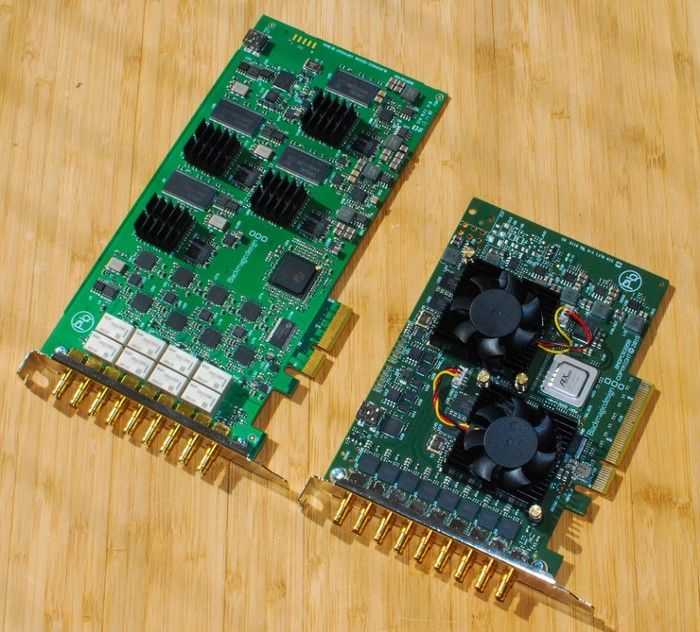DeckLink Quad 2: quick test and first impressions

The original DeckLink Quad was announced in 2011 at NAB as “4 separate DeckLink capture cards” that plug into just one PCIe slot. Four years later, at IBC 2015, Blackmagic Design announced Quad 2 — a “capture and playback solution that puts the power of 8 DeckLink cards onto a single circuit board”. Well, finally the new board is in our lab and we can put it through some initial tests.
First look
The new board is smaller than the original Quad. Instead of 4 radiators, there are two coolers that are built into larger radiators — and reasonably: since the board provides twice the processing power on a smaller surface, it needs better cooling.
Just like the original Quad, the new board has 9 3G-SDI connections, but here each of the 8 channels is bi-directional (you can configure it for either in our out), whereas the old Quad used 2 connections for each of the channels (one for input, one for output — it wasn’t possible to configure each of the connectors to be in or out). The 9th connection is for the reference signal (genlock). Both are PCI Express (PCI-e), but the Quad 2 is wider, so it probably requires more bandwidth — see out tests with expansion systems below.
The Quad 2 supports SDI formats in SD and HD up to 1080p60. Blackmagic states, that each of the 8 connections is completely independent and “can input or output entirely different video standards and content streams, all at the same time”. This means that you can use the board in any combination of inputs and outputs.
Just like the original Quad, the new board retails for $995. Blackmagic has pushed the cost per channel to under $125.
The system did not detect the new board until 10.6.1 drivers were installed (10.6.2 have become available now, and we tried them too). The Blackmagic Video Desktop Utility shows Quad 2 as two DeckLink Quad devices, but allows you to work with it as with 8 independent DeckLink devices. Cool.
By default the drivers will configure the devices for just only 4 channels to work. The other connectors have to be configured manually via the Blackmagic Desktop Video Utility:
- Open the Utility and choose DeckLink Quad 2:

2. Go to the device’s properties:

3. Select the required connector in the “Connector Mapping” property:

4. Hit “Save” and repeat for other connectors.
After this configuration the inputs/outputs will appear as advertised on Blackmagic’s web site:

Usage with expansion systems
We like using Macs (running Windows, of course) because of their Thunderbolt connection, which allows us to use expansion systems with our MacBook Pros. But it wasn’t all that smooth with the Quad 2. Our Magma (Thunderbolt 1) detects 4 channels randomly and our Sonnet (Thunderbolt 2) detects 8 channels, which seem to work okay separately. Multi-channel ingest also seems fine, but only 5 channels could be played out at the same time.
It seems the bus on these devices does not provide enough bandwidth, so we recommend plugging the Quad 2 into a full-time motherboard.
We used MPlatform to play out an HD 1080 50i signal out to the DeckLink Quad 2 (channel 4). It was received by a SmartView Duo and from there it was sent back to the DeckLink Quad 2 (channel 5). This resulted in a 1 frame delay between the Quad 2 (channel 4) and SmartView Duo and 2 frames between SmartView Duo and Quad 2 (channel 5). So a total of 3 frames. In order to improve output stability, the output buffer in MPlatform can be increased, but it makes no sense to bring the overall delay up to more than 4 frames, which is still pretty good!

So, its official: DeckLink Quad 2 is now officially supported by MPlatform and MFormats SDKs.
